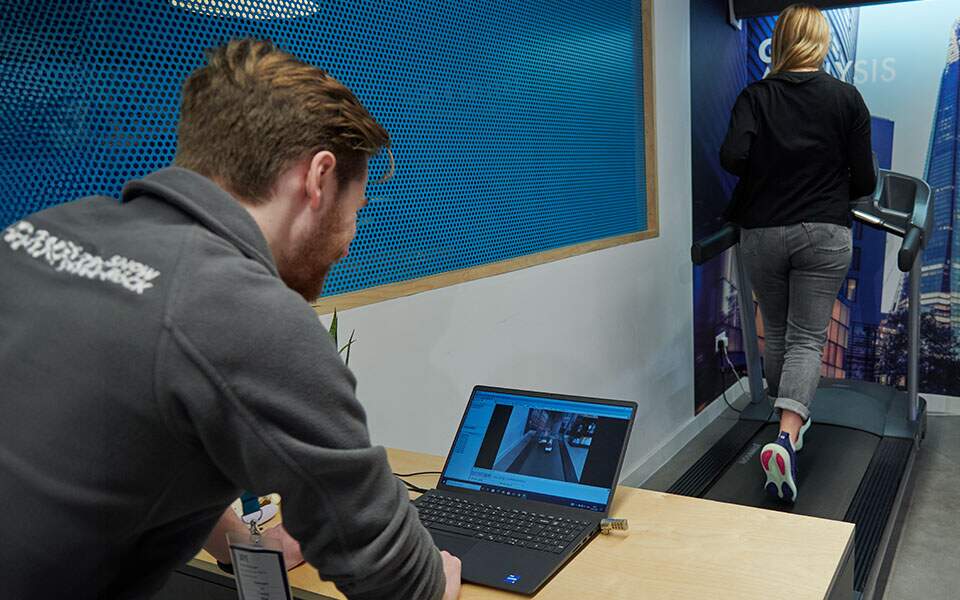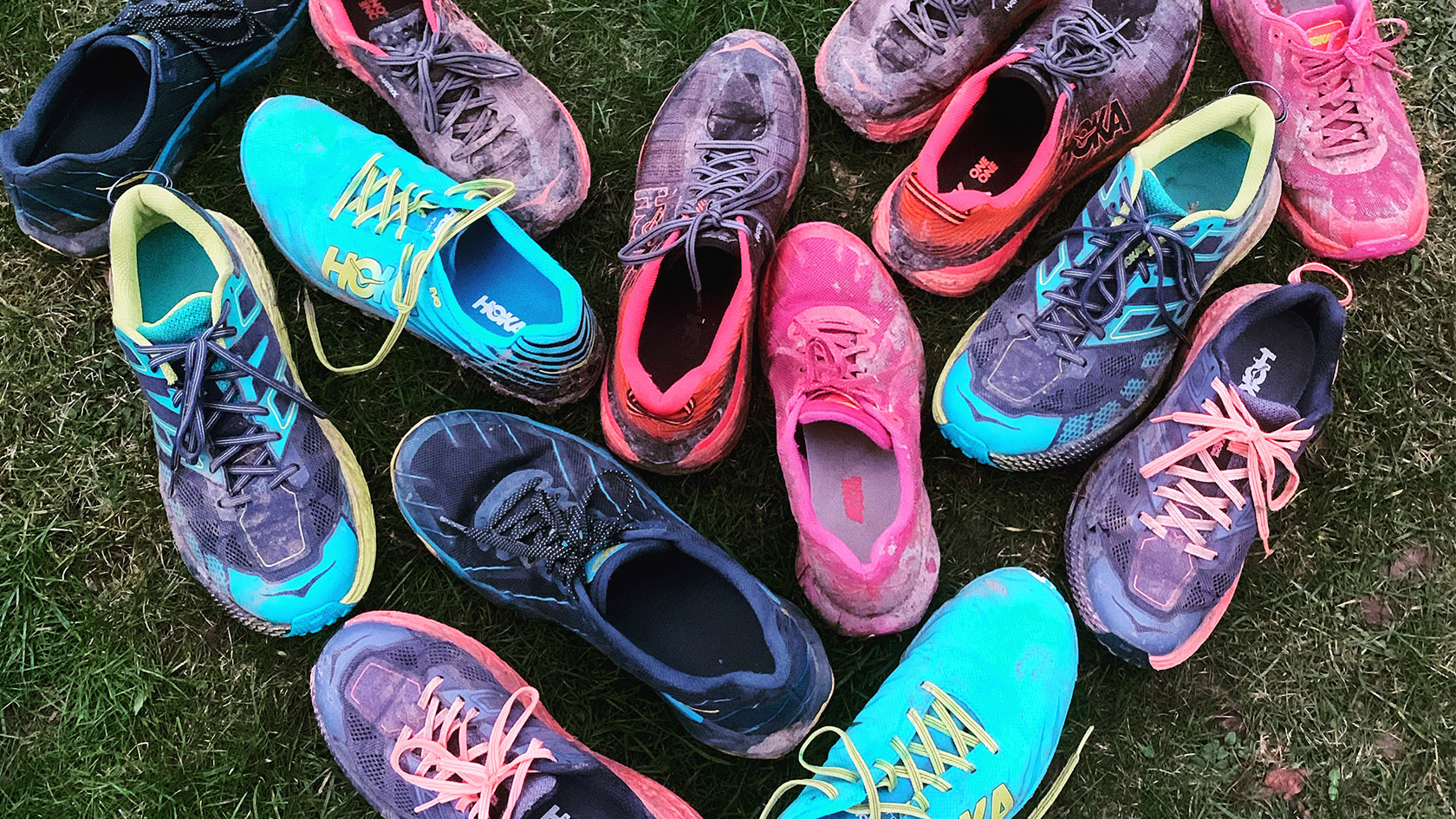GAIT ANALYSIS EXPLAINED
Let our expert staff help put you in the right running shoes...

Gait Analysis is a service we provide at all Runners Need stores to help determine the best shoe for you. An expert Gait Analysis appointment is free with the purchase of running footwear in-store or online within 30 days - otherwise, this service costs £15.
To help start the gait analysis process with you, we will first talk to you about your current running style, any future running goals, events, or aspirations you have planned, and any previous injuries that may affect how you run.
What does an average Gait Analysis appointment look like?
An in-store Gait Analysis appointment takes around 30 minutes and will require you to run a steady pace for around one minute in a neutral shoe chosen by our experts. We advise booking a slot in advance, which you can do here.
To begin with, we will place you in a neutral shoe and get you running on our treadmill for around 20-30 seconds to let us record your running style. This will allow us to look at how your feet are landing, where they are landing, and for any misalignments biomechanically within your ankles or knees.
Once we have finished recording your run, we will show you a frame-by-frame replay while explaining key points about your running style. By looking at how you run on the treadmill and using what you have previously told us about your current running technique and any future running goals, events, or aspirations you have planned, we can understand what type of shoe will best suit your run.
At Runners Need, we stock a wide range of road, race, and trail running shoes to ensure there's something for everyone in store. From minimal, quick shoes for racing to super supportive, cushioned shoes for daily runs on the tarmac, we have a wide selection of brands, including men's and women's Nike trainers.
Using the data from your gait test and preferences, we will pull a few shoes from our extensive range that we believe will best suit you and your goals for you to try and experience. Comfort and support are key for the mileage you're planning to run. Depending on your running style, stability elements in a shoe may help control the movement inwards at the ankles. It's why it's great to come and experience these shoes in-store to help find the perfect shoe for you and your running goals.
All Runners Need stores offer Gait Analysis
To get your gait analysed, just find your nearest Runners Need store and book your appointment here.
Step into innovation with our 3D Foot Scan service, available when you book a Gait Analysis appointment at select stores.
Our 3D Foot Scanning service uses cutting-edge technology powered by Volumental to create a detailed 3D model of your feet. After stepping on the scanner, our 3D Foot Scanner gathers precise measurements in seconds, giving insight into your unique foot shape and size. This data helps our experts identify the perfect shoes to match your unique profile, ensuring your new footwear is comfortable from the get-go - so you can confidently chase your running goals.
Understanding pronation: Overpronation, underpronation, and neutral pronation
Pronation refers to how your foot rolls inwards as it strikes the floor while moving. Your pronation is your body’s way of distributing impact as you move and is a natural part of your gait cycle. Understanding your pronation is vital to selecting the correct type of running shoe for you and your run and can ultimately help you avoid injury.
There are three pronation types:
OVERPRONATION

Around 70% of the population overpronate, making overpronation the most common pronation type amongst runners by far. As you plant your foot down, it rolls inward excessively, transferring weight to the inner edge instead of centring it on the ball of the foot. Overpronation is often seen in runners with low arches or flat feet.
Recommended shoe: Stability
UNDERPRONATION

Also called supination, undepronation is where the outer side of your foot strikes the ground at a steeper angle with little or no movement inward. This movement causes a jarring effect and a large transmission of shock through the lower leg. Underpronation and supination are common in runners with high arches.
Recommended shoe: Neutral
NEUTRAL

Neutral pronation occurs when the foot lands on the outer edge and then rolls inward in a controlled manner, distributing weight evenly and helping to absorb shock. On push-off with neutral pronators, there is an even distribution of pressure from the front of the foot.
Recommended shoe: Neutral
How to determine your pronation type
If you're unable to come in-store for a Gait Analysis appointment, the "Wet Foot Test" can give you a rough estimate of your pronation type. The Wet Foot Test can be helpful if you're concerned your gait may have changed since your last assessment, but it is important to stress this should only serve as a guide. For a true gait analysis and specialist advice on the right shoe for you, please schedule a Gait analysis appointment at your local Runners Need store.
The Wet Foot Test
To perform the Wet Foot Test, simply wet the sole of your foot, step onto a piece of heavy-duty paper – or a dark tile or paving slab – and examine the footprint you leave behind.
The degree to which the sole of your foot is visible in the footprint can help indicate your arch type and the kind of shoe that might suit you best.
Important advice to remember:
- The most expensive shoe isn't necessarily the right pair for you. Don’t be tempted into thinking that a higher price equals a better shoe.
- We usually recommend you buy trainers half a size to a size larger than your average to accommodate foot movement and swelling during running.
- Shoes that feel comfortable walking about the shop floor might not necessarily feel that way when running. Ensure you always take the shoes you intend to buy onto our treadmill in-store for a test run.
Frequently Asked Questions
Absolutely! Running regularly in the wrong type of shoe with a pronounced gait abnormality will almost certainly lead to more injuries in the long term. A Gait Analysis appointment takes about 30 minutes and can transform your running experience – so why take the risk? Pop into your local Runners Need and give yourself peace of mind.
Gait Analysis is free with the purchase of running footwear in-store or online within 30 days. Without a footwear purchase, our expert service is £15.
We recommend having a Gait Analysis appointment annually to adapt to your ever-changing running style, PB goals, and aspirations.
Although you may find a running shoe you love, brands often make small changes and updates to their designs, so a newer style or model may no longer be suitable. If you’re unsure, talk to one of our experts in-store.
Generally, you should seek to replace your running shoes every 300-500 miles, depending on your weight and the surface you run on. For someone who runs three miles three times a week, this would roughly be a new pair of running shoes every 10 to 12 months.
If you're still unsure, try the ‘Kitchen Bench’ test. Place the shoe on the counter - If you can make it rock with one finger on the heel or see the midsole has compressed, this is usually a sure sign to get a new pair. Similarly, if the sole is overly worn in one area more than others, it’s time for a new pair.
For more information, read our article on when to replace your running shoes.
While there is no set mileage to wearing in new running shoes, you should always take it easy and break them in before going long distances.
If you can, alternate your new running shoes with your old ones. Not only will you notice any changes between the old and new models, but you’ll also give your feet and legs a chance to re-adjust to the new pair, which will have firmer, less compressed cushioning.
To avoid injury close to an event, ensure that if you need new shoes, you replace them at least four weeks before a race.
Your running shoes should be comfortable from the moment you put them on. Breaking them in won’t change the way they fit, so if you’re getting blisters or the shoes are rubbing, they’re probably the wrong size.
Over 18's Only - We do not offer Gait Analysis for under 18's as their feet are still developing and growing.
Related articles:








